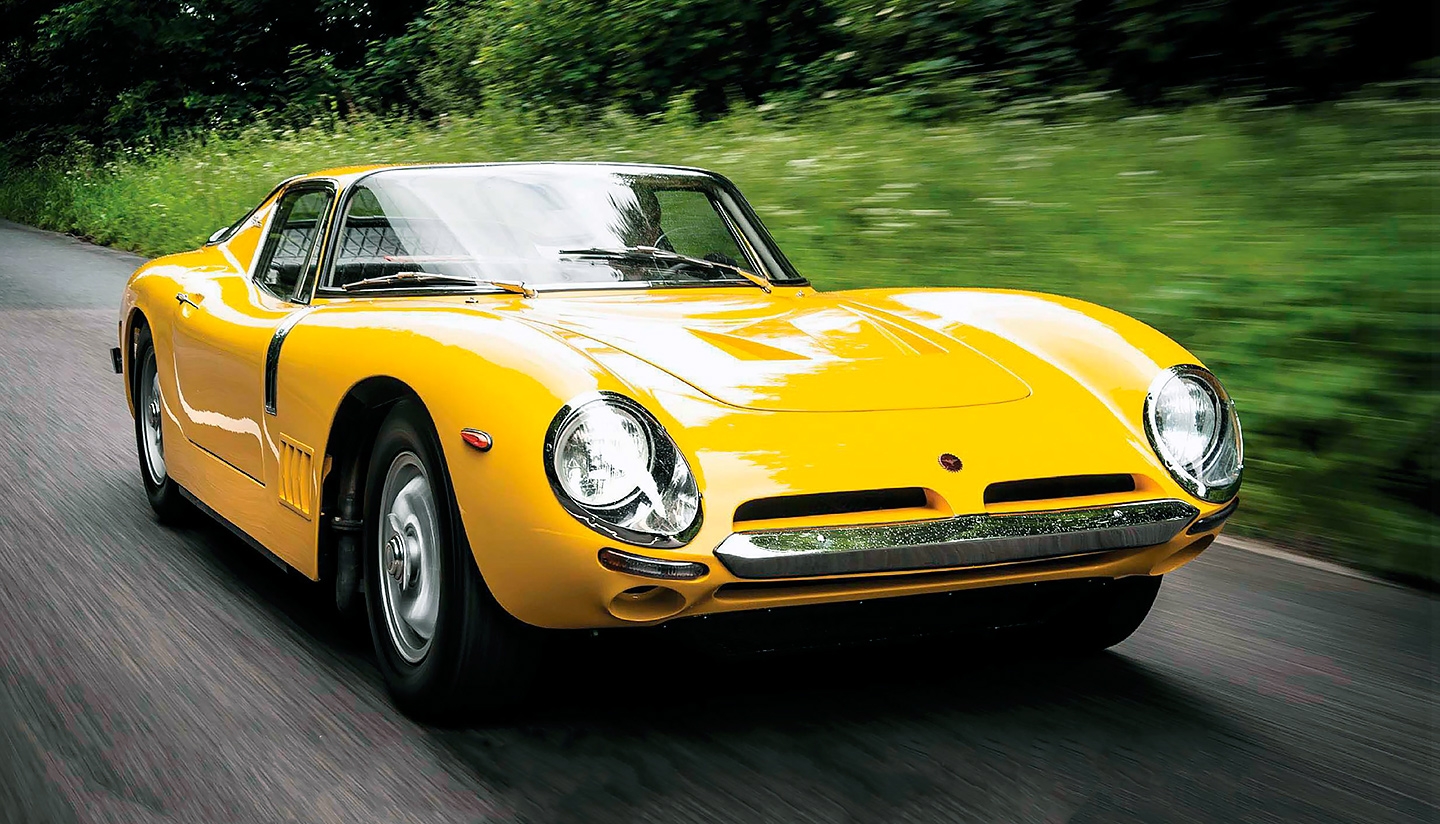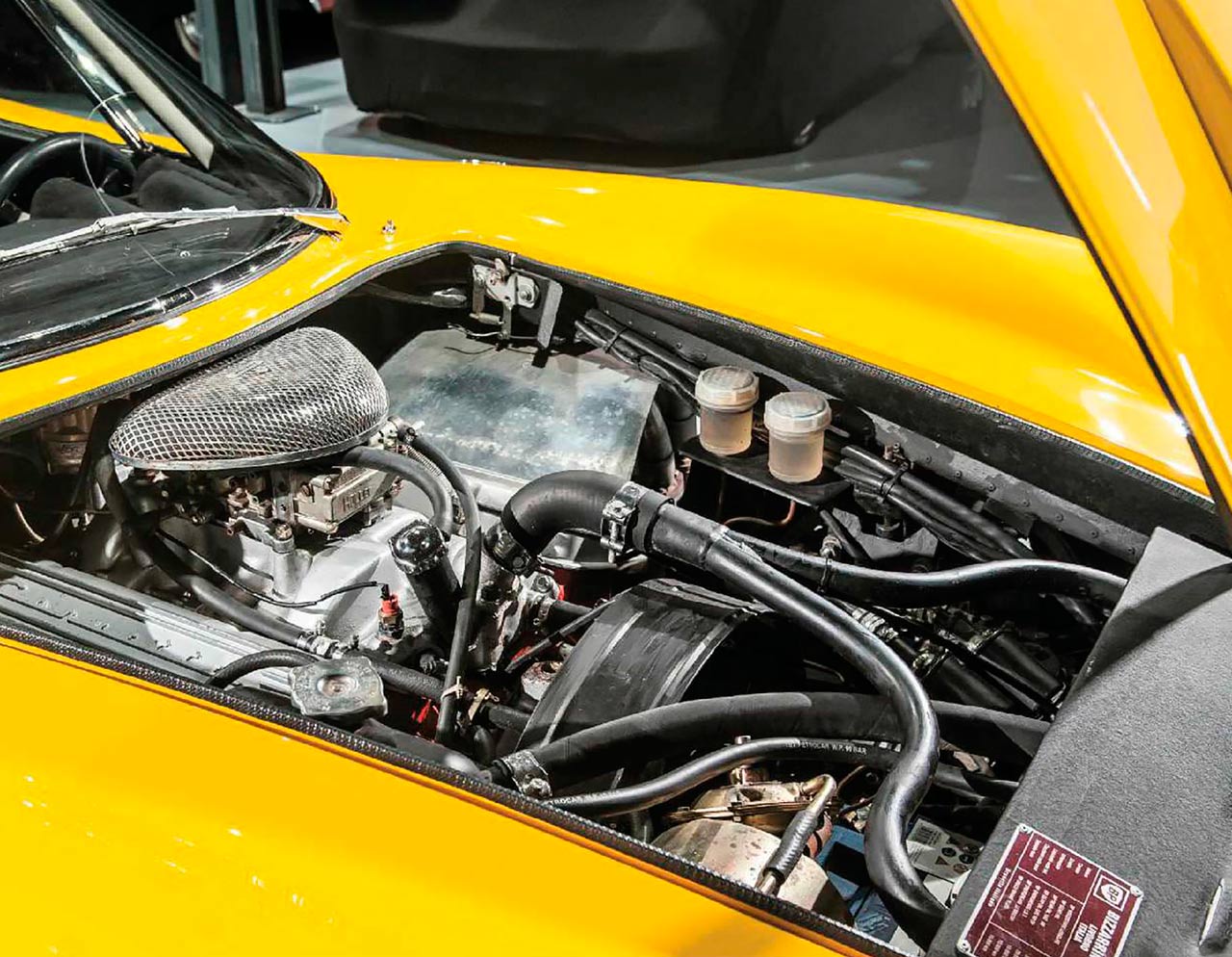
Thunder heart and light of foot Bizzarrini 5300 GT Strada. Bizzarrini Strada unleashed after a 27-year slumber. Expect to draw big crowds when you drive a Bizzarrini. This spectacular Bizzarrini 5300 GT Strada has been out of sight for nearly three decades. As it wakes from its slumber we climb in for an eye-opening drive. Words Ross Alkureishi. Photography Laurens Parsons. Bizzarrini The short-lived 5300GT Strada was born out of a passion for racing and is a spectacular road car. We drive the Italian supermodel with a thumping American heart.
Ensconced in the cacophonous Cucina Italiana on Orpington High Street this morning, with coffee aromas punctuated by wafts of hot butter, closing my eyes I can almost fool myself I’m in a café in Porto Livorno, just down the road from Pisa. Samuel Laurence’s sales manager Davide De Giorgi shatters the illusion as he opens the cafe door and, instead of the gentle lapping of the Mediterranean, the white noise of south London’s rush hour washes in after him. We shake hands and he lays a set of keys on the table.
[trailer_box style=”6″ image=”images/mews2015/drive2015/1966-Bizzarrini-5300GT-STRADA-1.jpg” title=”Tested” align=”center”][counter count_end=”141″ counter_speed=”6″ prefix=”Max Speed ” suffix=” MPH” count_color=”#ffffff” text_color=”#ffffff”]1966 Bizzarrini 5300 GT Strada[/counter][/trailer_box]
‘It’s here?’ I ask, seeing the distinctive Eagle emblem on the key ring. ‘Really?’ I stifle a laugh at the thought of an early alloy-bodied 5300 GT Strada sitting outside amid a sea of modern mundane machinery – especially one fresh from a meticulous restoration.
I settle the bill, step outside and there indeed, 50 yards up the road in a parking bay, sits an unfeasibly low and sleek aerodynamic vision in yellow, a glorious burst of Mediterranean sun illuminating everything in close vicinity. Even Sophia Loren perched on a plinth in her luscious prime would struggle to have the effect currently being provoked in the locals.

Campagnolo alloy wheels catch the eye, but the entire body is alloy too. Scripted badge tells you that this 5300GT is a road version. Those shapes remind you of anything? Bizzarrini oversaw the 250 GTO when he was chief engineer at Ferrari. Giorgetto Giugiaro designed those dramatic curves from a sketch by Bizzarrini himself.
I’m not immune either – Giorgetto Giugiaro’s seductive lines, realised from a sketch by Giotto Bizzarrini himself and made flesh by Piero Drogo’s Sports Car Modena works, ensure that gravity momentarily overcomes the resistance offered by my jaw muscles. It’s a visual symphony with a sweeping front, belligerent haunches and aggressive vents – all functional. Only the flat flanks housing fuel tanks in each sill interrupt its curves, and it’s free from adornment save for chrome bumpers and a touch of scripting.
Acutely aware of my audience, I open the light aluminium door, stretch my leg across the wide sill, insert it into the footwell, allow cheeks to meet seat, and then repeat with the left before a limbo manoeuvre brings my torso to the party. Once in, a bit of pedal Riverdance gets me comfortable.
The black leather bucket seat is supportive, but the footwell is narrow thanks to the wide transmission tunnel; the engine is set so far back in the chassis that the distributor is adjusted through a removable panel on the dashboard. The threespoke leather steering wheel sports a central Bizzarrini badge, but a rather large clue to the car’s heritage is visible in the Iso A/3Lbranded Veglia Borletti gauges.

Welcome to the Sixties. Turin company Ferraresi re-did the interior.
I prime the carburettor with several pumps of the throttle and it fires with a hollow clatter, which hardens to a thunderclap as the gargantuan Holley allows all eight cylinders to gorge on fuel. Even though I’m prepared for it, the fact that I’m greeted by the unmistakable sound of pure blue-collar American iron and not the wild tones of an Italian V12 still comes as a shock, the Chevrolet Corvettesourced V8 a seemingly odd partner to that sultry Italian body.
The clutch isn’t obtrusively heavy and the tall lever travels quite a distance but with a satisfying kink in the movement before the synchromeshes guide it home with a firm shove and accompanying mechanical clunk. There are no wing or door mirrors and turning in my seat reveals only a vast expanse of luggage room and a lottery of a view stacked against me. Thankfully Davide is on hand to wave me out.
There’s instant heft available even at the lowest revs and as they build I can feel the branched exhaust manifold resonating through the footwell – trying to imagine what that’s going to feel and sound like at full chat has me salivating. As I crawl along I change gear too early and momentarily bog the engine down; first gear is very tall so there’s little need to change up below 30mph.

Brutal engine and sophisticated chassis – no wonder he’s looking cheery. If the 5358cc V8 looks a long way back that’s because it is – so much so that you access the distributor through a hatch in the dashboard!
Heads on both sides of the street turn at the approaching rumble and a number of people hurriedly exit shops to identify the noise. This is by no means the Bizzarrini’s natural environment – raised pedestrian crossings challenge the sump’s two-inch clearance and mechanically it’s not at ease – but the suspension is supple and easily deals with road imperfections. I’m not complaining. The effect of the car is akin to The Emperor’s New Clothes, minus laughter and with genuine visual substance.
Finally, we shake loose our town centre anchor and start to build up some speed. I have to regulate throttle pressure, just as I would in a Corvette, because with 360lb ft of torque it’s easy to spin the rear wheels and send the tail drifting out – this example’s locked differential making it a smidgeon more rear-end happy than a standard example. Worse, I could propel it forwards too hastily and bury the bonnet into the back of the car in front. Lay down the power progressively and the level of mid-range surge is breathtaking; the redline sits at 5800rpm, but pretty much all the torque is delivered in the first three quarters of the rev range so second and third do the job perfectly in normal driving.
Working my way out towards the countryside and quieter roads I’m surprised at how easy this beautiful brute is to drive. As the miles pass I settle into a pulsating rhythm of bursts of heavy acceleration with the exhaust note hardening from rumble through blare to guttural snarl, followed by soothing cruising, with the engine burbling in the foreground. The acoustics mean that the 0-60mph sprint feels like it’ll take rather less than the claimed 6.8 seconds.
You could be forgiven for thinking that mechanically the engine is the star of the show here – or villain, for purist Italian car aficionados – yet that honour goes to Giotto Bizzarrini’s engineering prowess. Setting the engine 16-inches further back in the chassis – as with Iso Grifo – resulted in far better balance than its Iso Rivolta GT forebear, and that’s clear through both slow and fast corners.
Prior to entry, a hard foot on the brake pedal is welcome; the all round discs are more than adequate but require a hefty shove to wake them up. It feels as if the car is squatting on all four tyres rather than nose-diving and the pedal will take quite a push before the wheels lock.
Get braking done early, load up the steering and there’s immense grip, the handling remaining neutral – period road tests state that it will understeer on the limit, but I’m far from there today. As the road straightens, it’s hard on the throttle as I let the brute off the leash once more – it’s gloriously bawdy and addictive.
That it matches aesthetic beauty with a chassis that delivers such a balanced driving experience should come as no surprise. Giotto Bizzarrini was schooled at the University of Pisa, from where the Tuscan mechanical engineering graduate joined Alfa Romeo, working on the development of the Giullieta Sprint, Spider and Berlina before moving to Ferrari in 1957. There he swiftly rose to the position of chief engineer, working on the 250 2+2 and 250 SWB before completing the initial development on the now legendary 250 GTO.
Unfortunately, those labours would not be completed by Bizzarrini himself, because as one of the gang of five during Modena’s infamous Machiavellian palace revolt, Enzo Ferrari famously cast him forever into the wilderness. After a brief dalliance with Count Giovanni Volpi’s ATS car-making and short-lived racing team, he designed and built the glorious V12 engine which powered Ferrucio Lamborghini’s new 350 GT. It was an engine that, in numerous models, would last an inconceivable five decades in production.
His next stop was another rich industrialist’s project – the luxury four-seater Iso Rivolta GT. His chassis design was teamed with an elegant Giugiaro-penned body and, in a first for an Italian GT, a Chevrolet Corvette V8, which instantly removed difficulties with servicing and parts support in the all-important US market. But with racing fuel coursing through his veins it was inevitable that Bizzarrini would push in that direction and the result was the two-seater Iso Grifo. Debuting at the 1963 Turin Motor Show, in both road-going A3/L and A3/C racer forms, it featured a shortened Rivolta chassis with the engine now set much further back.
On track, the racer would come 14th overall in the 1964 Le Mans 24 hours with a class win in the over 5.0-litre category the following year. But patron Renzo Rivolta had little interest in track efforts and with both wanting to take such radically different roads, their relationship inevitably broke down. Astutely, Bizzarrini had previously registered the Grifo name and, in exchange for its continued use by Iso, he was able to secure parts and continue to build the car under his own banner at Società Autostar (later Bizzarrini) in his home town of Livorno.
The car was produced in three forms: 5300 GT Strada (road); Corsa (race); and GT America (glassfibre bodies replacing the riveted all-alloy unit, and independent rear suspension instead of a De Dion set-up). Bizzarrini continued to trade but production would come to an end after just three years; unfortunately, his business acumen didn’t match his engineering skill.
This example is one of 139 GTs officially built – although the exact number is thought to be closer to 100. Chassis #0260 is the only Bizzarrini to have been registered in the republic of San Marino and its first owner was crooner and film star, Antonio Ciacci. He called himself Little Tony and was also known as the Italian Elvis, thanks in part to his endearingly flashy style but mostly because of his passing resemblance to The King.
His considerable success in the charts and on screen allowed him to build an impressive collection of Italian sports cars, including the Bizzarrini – it featured in a photo shoot in the March 1967 edition of ‘gentlemen’s publication’ Kent, as well as his motion picture film Riderà that same year. In 1968 it was sold to Vittorio Tommasini of Bologna before going to the States three years later with Nick Tomljanovich. In 1991 it was sold to Enrico Laudicino and returned to Italy. By then its form was much modified – roof periscope, front air dam and tail spoiler. The inevitable restoration wasn’t finished before current owner A Salzano took possession in 2007. He commissioned Mabert of Villastellone, Turin, to restore the body while Managlia of Modena rebuilt the engine. Ferraresi redid the interior, with the leather by Foglizzo – both based in Turin.
The result and colour combination ensure that it’s one of the most striking of the Bizzarrinis, yet despite being an impressive driving experience I’m still not sure I fully get the car. There’s only one thing left to do. It’s surely most people’s idea of driving hell, but today, in this car, it’s perfect. Approaching a roundabout I signal right, take the second exit and thunder down the slip road on to a blessedly clear M25 motorway as the road straightens.
The engine is throatily vocal, emitting surprising higher pitches as it climbs the rev range; like all big Sixties sports cars the feel is right when there’s too much of it. Underfoot the exhaust pipes transmit a great deal of sound, heat and vibration, which puts me in brutally direct communication with the car. It’s hot, loud, then it gets shaky, and then it gets hotter and louder. But it’s all good – I’m smiling and the scenery is flashing past as the Bizzarrini devours other vehicles on the motorway. This long-distance runner now makes complete sense on my makeshift high-speed oval. Unlike an early Miura it’ll remain stable up to a top speed of 161mph – not Bizzarrini’s claimed 180mph – and the drivetrain feels indestructible, as if it could continue there without issue for, oh, say, 24 hours.
The Iso Grifo A3/C’s 1964 Le Mans debut demonstrated the 5300 GT Strada’s potential. Surely its combination of slippery aerodynamics coupled with robust running gear could have seen it further developed to compete with the Ferrari 275P, 330P and 250 GTO. Alas, a patron with so little interest in motor racing coupled with a shoestring budget meant that potential would remain unfulfilled, and for Bizzarrini himself that must have been a regret.
So where does that leave the 5300 GT Strada? As a brand, Bizzarrini was an impudent middle finger to Ferrari. Couple that to the Italians’ love of beautiful and sophisticated engines – an American V8 is neither – and it’s always been frowned upon. Though it doesn’t have the prestige and period race success of rivals, it remains one of the most spectacular-looking cars ever designed, and yet one you could service on your driveway. No wonder it’s so sought-after now. As I step out, trembling from the buzz of my morning drive, I realise that I owe Enzo Ferrari a debt of gratitude for unleashing Giotto Bizzarrini to do his own thing.
Thanks to: Samuel Laurence (samuellaurence.com), where the car is currently for sale.
TECHNICAL DATA FILE 1966 Bizzarrini 5300 GT STRADA
Engine 5358cc V8, ohv, four-barrel Holley carburettor
Power and torque 350bhp @ 6000rpm; 360lb ft @ 3600rpm
Transmission Four-speed manual, rear-wheel drive
Brakes Magnesium Campagnolo discs front and rear, twin servos
Suspension
Front: wishbones, coil springs, telescopic dampers, anti-roll bar
Rear: trailing arms, de Dion tube, Panhard rod, coil springs, telescopic dampers
Steering Recirculating ball
Weight 1243kg (2740lb)
Performance 0-60mph: 6.8sec;
Top speed: 161mph (est)
Fuel consumption 16.5 mpg
Cost new n/a
Values now (UK / USA 2017) £400,000-£600,000
OWNING A BIZZARRINI
‘I come from a Porsche family,’ says A Salzano. ‘But I always had a passion for real exotics, and Bizzarrinis in particular. When I saw this car in 2007, I simply had to have it. Since new it had passed through several owners and returned to its original region of Tuscany but I had an educated guess of exactly what the chassis was and the special story that came with it.

‘The research work took a long time to conduct and I can’t quantify the costs of the restoration. Having stalled as a project with the previous owner it was in disrepair when I found it, but I got lucky because it came with a lot of original parts.
‘It has a lot of crazy little details like a locked differential and exhaust pipes that really warm up the footwell, but it’s definitely all been worth it. As more of a soft race car than a GT, it’s quite a harsh and demanding drive; I think that’s one of its most fascinating aspects but I can understand that it doesn’t appeal to everyone.
‘Giotto took it long-distance racing with the Iso Grifo, so it’s a very reliable car – even the engine is easy to maintain.’
“It fires with a hollow clatter which hardens to a thunderclap”
“When I let this brute off the leash, it’s gloriously bawdy and addictive”






